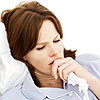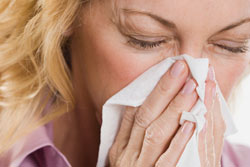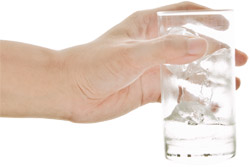- Foods for cold and flu symptoms
- Fighting a fever with food
- Help headaches with hydration
- Cure a sore throat with plenty of fluid
- Remedy a cough with honey and lemon tea
- Drink if you’ve got diarrhoea
- Nausea and vomiting nutrition
- Frequent meals when appetite is reduced
- Stop a runny nose with chicken soup
- Clear a blocked nose with hot drinks
- Clear blocked sinuses with spicy foods
- Swallowing is easier with soft foods
- Vitamin and mineral supplements for cold and flu symptoms
Cold and flu- what to eat and drink
Cold and flu symptoms are unpleasant, but many symptoms can be relieved by eating and drinking certain foods and beverages. Eating and drinking are also important for preventing dehydration and weight loss which may occur during periods of cold and flu infection. The best combination of foods and drinks depends on the specific symptoms you are having, for example whether you’re coughing and feverish, or have a sore throat and a blocked nose.
Fighting a fever with food and fluids
Fever often accompanies a flu. While eating and drinking cannot cure a fever, consuming enough healthy foods and fluids to maintain hydration and minimising weight loss is important. If you have a cold or flu you may not feel like eating much, however your body is using more energy to fight the infection. Energy expenditure is particularly high when you have a fever. The amount of energy the body uses increases by 13% in adults for every 1oC increase in body temperature.
Drinking plenty of fluid is important during fever as the sweating that usually accompanies a fever increases water loss. Adults should drink eight 250ml cups of fluid per day. Children aged over one year need a minimum of 90-120ml of fluid per hour and babies require at least 30-60ml fluid per hour.
Help headaches with hydration
Dehydration can contribute to headaches. Maintaining adequate fluid intake is also important if you experience headaches during cold and flu infection.
Get on top of your general health
Find and instantly book affordable GPs within Australia
Cure a sore throat with plenty of fluid
Drinking plenty of fluids helps lubricate and relieve a sore throat and both food (as soups, smoothies etc) and drinks can be used as fluids.
Lozenges including sugar free medicated lozenges suitable for diabetics are available for temporarily relieving sore throats. Their consumption increases saliva production and lubricates the throat.Any type of hard candy will have a similar lubricating effect, although medicated lozenges may have additional benefits because they also contain local anaesthetic, antiseptic and/or counter-irritant ingredients.
Soft foods will be easier to swallow with a sore throat and some soft foods like hot soup may also help relieve this symptom.
Sore throats associated with post nasal drip (excessive mucus which runs from the nose to the throat) may also be associated with acid mucus. Drinking a teaspoon of liquid antacid may help. You should not drink anything for a short time after drinking the antacid, as the aim is to coat the throat with the antacid and neutralise the acid in the mucus. Drinking too soon after swallowing antacid will wash it away before it has time to neutralize the acid.
Get on top of your general health
Find and instantly book affordable GPs within Australia
Remedy a cough with honey and lemon tea
Maintaining adequate hydration by drinking plenty of fluids helps relieve a productive cough. Drinking at least eight 250ml glasses of water daily has the same benefit as using expectorant cough medicine (one which loosens mucus in the throat). Hot lemon and honey tea may relieve coughing. It’s a good option for night time coughing which disturbs your sleep.
Frequent meals when appetite is reduced
When you have a cold or flu your appetite is usually reduced. If you don’t feel like eating much, try smaller more frequent meals to ensure you eat enough to meet your nutritional requirements. This is particularly important during pregnancy. Soft food may be easier to swallow during cold and flu infection.
Stop a runny nose with chicken soup
When the nose produces more mucus as it does when you have a cold or flu, it increases water loss. Maintaining fluid intake is therefore important. Eating chicken soup, previously thought to be merely an old wives’ tale, has been shown to have a mild anti-inflammatory effect that helps to clear mucus from the nose.
Clear a blocked nose with hot drinks
Maintaining fluid intake helps to loosen mucus and relieve congestion. Drink water or other fluid whenever you are thirsty and use your thirst as a guide to how much you should drink. During cold and flu you should drink a minimum of eight 250ml cups of fluid each day.Hot beverages are ideal as the hot steam they produce can relieve congestion.Tea made from lemon and honey is a good option.
Chicken soup is a mild anti-inflammatory and also helps clear mucous from the nose and reduce congestion.Menthol sweets may also help relieve a blocked nose.
Many people believe that milk and dairy products increase congestion and should be avoided; however, this is not the case. Dairy products should not been withdrawn from the diet.
Clear blocked sinuses with spicy foods
Spicy foods may help relieve blocked sinuses. They include foods containing horseradish and hot peppers.
Drink if you’ve got diarrhoea
Diarrhoea increases water loss and drinking plenty of fluids is essential for preventing dehydration, particularly in children. Sip water frequently throughout the day. Adults may prefer to drink non-caffeinated soft drinks, sports drinks, fruit juice or salty broths; beverages which contain sodium, potassium and chloride are good options, because these salts are also lost from the body with diarrhoea. Children should drink water or oral rehydration solution. Babies should continue breast or bottle feeding. Soft drinks and juice should be avoided in children as they can cause diarrhoea to worsen. Oral rehydration salts which are mixed with water replace fluid, salts, glucose and other important minerals and should be used if you or your child is dehydrated or at risk of becoming so.
If you experience diarrhoea during cold and flu infection eat when you feel you are able to. If you can’t tolerate any food, make sure you keep drinking plenty of fluid until you are able to eat. Small, light meals should be consumed, but there is no need to avoid solid food, except in children who are dehydrated. In these cases solid food should only be offered when the child has consumed enough fluid to ensure they are properly hydrated.
When you’re ready to eat again, start with bland foods, for example:
- Plain rice
- Boiled potatoes;
- Plain toast;
- Crackers;
- Baked chicken with the skin and fat removed;
- Vegetable broth;
- Bananas.
Foods which may trigger diarrhoea should be avoided. These include:
- Caffeinated beverages including coffee, tea and some soft drinks;
- Fatty, greasy and/or fried foods;
- High-fibre foods including citrus fruits;
- Sugary foods like cakes and lollies.
Some people find it more difficult to digest lactose during periods of diarrhoea. If this applies to you avoid dairy products, with the exception of yoghurt which is usually tolerable. Yoghurts containing live bacterial cultures may reduce the duration of diarrhoea.
Relieve nausea and vomiting
Dry, bland foods are best if you are nauseous (dry toast or crackers are good food options) and solid foods should be avoided if you are vomiting. Fried, greasy and sweet foods should be avoided and hot and cold foods should not be eaten simultaneously. Nausea may be relieved by sucking ginger candy or drinking ginger ale. Cold, clear beverages are recommended for nausea. Sip them slowly.
Vomiting causes rapid water loss and fluid intake must be increased to avoid dehydration. Water, fruit juice, saltybroth, non-caffeinated soft drinks or oral rehydration solutions are good beverage options for adults. Beverages containing caffeine or alcohol should be avoided. Children should drink water or oral rehydration solution. Babies should continue breast or bottle feeding. Oral rehydration solutions should also be used by adults if vomiting persists for more than 24 hours. Sucking on ice cubes may also be useful if you have difficulty tolerating fluids.
You probably won’t feel like eating much if you are nauseous or vomiting. When you can eat, choose nutritious food from a variety of food groups to ensure you consume a range of nutrients. When you are able to tolerate food, begin by eating dry, bland foods like plain rice or toast, boiled potatoes, lean meat and bananas. Avoid fatty and sugary foods.
Swallowing may be easier with soft foods
Infections can cause narrowing of the food pipe and this may lead to dysphagia (difficulty swallowing). This condition sometimes occurs as a symptom of common cold. If you have dysphagia you may have difficulty swallowing or in severe cases you may be unable to swallow at all. Dysphagia may also make chewing food difficult. This makes eating and drinking enough challenging.
The types of foods which will be easiest to swallow vary depending on the person, for example some may find thin liquids easiest to swallow while another person may prefer thick liquids. Eat slowly and take small mouthfuls. Try swallowing each mouthful of food twice to avoid food that is not swallowed getting into the windpipe.
Vitamin and mineral supplements for cold and flu symptoms
The effectiveness of several vitamins and minerals including zinc, vitamin C and echinacea has been investigated for relieving cold symptoms, either by making the symptoms less severe or shortening their duration. However, the studies used vitamin and mineral supplements (e.g. zinc lozenges, vitamin C tablets) rather than foods containing these vitamins and minerals (because the large quantities of vitamins and minerals contained in supplements are very difficult to obtain from eating healthy foods like fruits and vegetables).
Evidence for the effectiveness of vitamin and mineral supplements is limited. Zinc lozenges may reduce the duration of cold symptoms if you start taking them within 24 hours of your symptoms beginning. High doses of vitamin C may have a modest benefit for cold symptoms; however they may also produce side effects including diarrhoea, kidney stones and abdominal cramping. There is limited evidence that Echinacea is effective in relieving cold symptoms.
More information
 |
For more information on the common cold and influenza, types of influenza and treatments and tips for preventing influenza, see Cold and Flu. |
References
- Logan T. Healthy eating tips for cold and flu season. 2008. [cited 16 June 2013]. Available from: [URL Link]
- American Lung Association. Cold and Flu Guidelines. 2013. [cited 16 June 2013] Available from: [URL Link]
- Covington TR, Henkin R, Miller S, Sassetti M, Wright W. Treating the common cold: An expert panel consensus recommendation for primary care clinicians. Guidelines. 2004; 5(4): 1-16 [online]. Illinois Academy of Family Physicians. October 2004 [cited 6 June 2011]. Available from: [URL Link]
- Wiskin AE, Davies JH, Wooten SA, et al. Energy expenditure, nutrition and growth. Arch Dis Childhood. 2011; 96(6): 567-72. [Abstract]
- Brown University Health Education- Colds. 2013 [no date]. [Cited 31 May 2013]. Available from: [URL Link]
- Brown University Health Education- Flu (influenza). 2013 [no date]. [Cited 31 May 2013]. Available from: [URL Link] WA Health. What to do if you think you’ve got the flu. 2008. [cited 18 April 2013]. Available from: URL Link
- National Institute of Health and Care Excellence. Common Cold. 2011. [cited 21 June 2013]. Available from: [URL Link]
- University of Kentucky- Cooperative Extension Service. Nourishing a sick child. 2001. [cited 29 June 2013] Available from: URL Link
- Brown University Health Education Headaches. No date. [cited 29 June 2013] Available from: [URL Link]
- Victoria Health. Colds and flu. 2011. [cited 21 Junes 2013] Available from: [URL Link]
- University of Maryland Medical Centre. Colds and the flu. 2013. [cited 21 June 2013] Available from: [URL Link]
- National Health Service. Treating Diarrhoea. 2012. [cited 30 June 2013]. Available from: URL Link
- National Institute of Diabetes, Digestive and Kidney Disorders. Diarrhoea. 2011. [cited 30 June 2013]. Available from: [URL Link]
- Cleveland Clinic. Nausea and Vomiting. 2010. [cited 29 June 2013]. Available from: URL Link
- National Institute of Diabetes, Digestive and Kidney Disorders. Viral gastroenteristis. 2011. [cited 30 June 2013]. Available from: [URL Link]
- University of Michigin. Cold and Flu during pregnancy. No date. [cited 29 June 2013]. Available from: URL Link
- National Institute on Deafness and other Communication Disorders. Dysphagia. 2010. [cited 30 June 2011] Available from: URL Link
- Hamilton J, Sperry D. Dysphagia. Ontario Association of Speach-language pathologists and audiologists. 2011. [cited 30 June 2013]. Available from: [URL Link]
All content and media on the HealthEngine Blog is created and published online for informational purposes only. It is not intended to be a substitute for professional medical advice and should not be relied on as health or personal advice. Always seek the guidance of your doctor or other qualified health professional with any questions you may have regarding your health or a medical condition. Never disregard the advice of a medical professional, or delay in seeking it because of something you have read on this Website. If you think you may have a medical emergency, call your doctor, go to the nearest hospital emergency department, or call the emergency services immediately.











